China sends missiles to contested South China Sea island, say Taiwan, US officials
BEIJING – Reuters

AFP photo
China has deployed an advanced surface-to-air missile system to one of the disputed islands it controls in the South China Sea, Taiwan and U.S. officials said, while Chinese FM Wang Yi on Feb. 17 sought to downplay reports that China had positioned anti-aircraft missiles.
Taiwan defense ministry spokesman Major General David Lo told Reuters on Feb. 17 that the missile batteries had been set up on Woody Island. The island is part of the Paracels chain, under Chinese control for more than 40 years but also claimed by Taiwan and Vietnam.
A U.S. defense official also confirmed the “apparent deployment” of the missiles, first reported by Fox News.
Wang said the reports were created by “certain Western media” that should focus more on China’s building of lighthouses to improve shipping safety in the region.
“As for the limited and necessary self-defense facilities that China has built on islands and reefs we have people stationed on, this is consistent with the right to self-protection that China is entitled to under international law so there should be no question about it,” Wang told reporters in Beijing.
China claims most of the South China Sea, through which more than $5 trillion in global trade passes every year, and has been building runways and other infrastructure on artificial islands to bolster its title.
The United States has said it will continue conducting “freedom of navigation patrols” by ships and aircraft to assure unimpeded passage through the region, where Vietnam, Malaysia, Brunei, the Philippines and Taiwan have rival claims.
Admiral Harry Harris, the commander of the U.S. Pacific Command, said the deployment of missiles to the Paracels would not be a surprise but would be a concern, and be contrary to China’s pledge not to militarize the region.
“We will conduct more, and more complex, freedom of navigation operations as time goes on in the South China Sea,” Harris told a briefing in Tokyo. “We have no intention of stopping.”
Meanwhile, U.S. President Barack Obama said on Feb. 16 that he and leaders of Southeast Asian countries discussed the need to ease tensions in the South China Sea, and agreed that any territorial disputes there should be resolved peacefully and through legal means.
But a joint statement agreed on after a two-day summit with the Association of Southeast Asian Nations at the Sunnylands retreat in California did not include the specific mentions Washington had been seeking regarding China and its assertive pursuit of territory in the South China Sea.
Obama told a news conference that leaders at the meeting reaffirmed “our strong commitment to a regional order where international rules and norms and the rights of all nations, large and small, are upheld.”
“We discussed the need for tangible steps in the South China Sea to lower tensions including a halt to further reclamation, new construction and militarization of disputed areas,” Obama said. “When ASEAN speaks with a clear and unified voice, it can help advance security, opportunity and human dignity.”
